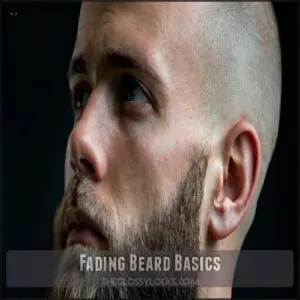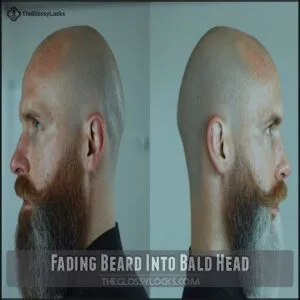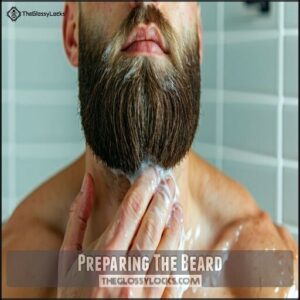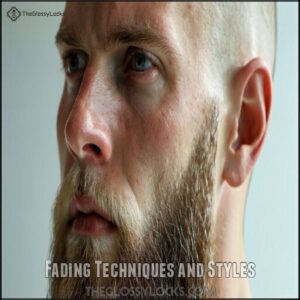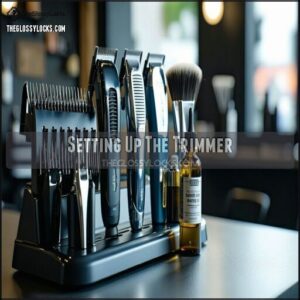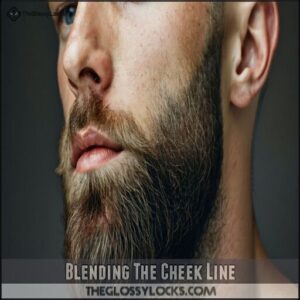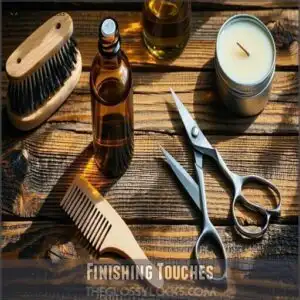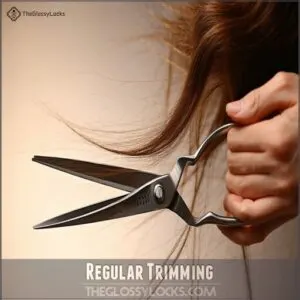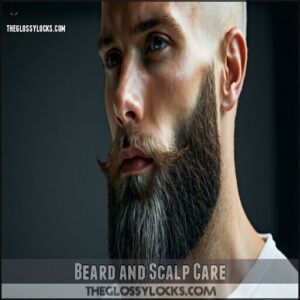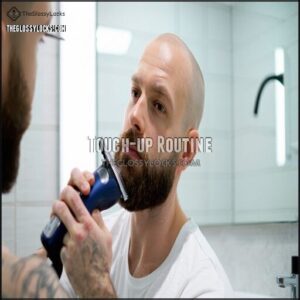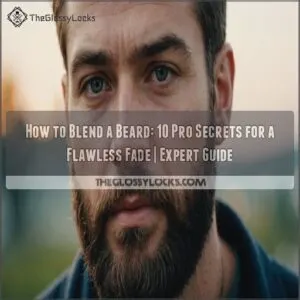This site is supported by our readers. We may earn a commission, at no cost to you, if you purchase through links.

Start with clean, moisturized skin. Use a trimmer with adjustable guards, beginning with a higher setting near the beard line and gradually reducing the guard as you move upward toward the scalp.
Focus on even strokes, blending the sideburns and cheek line seamlessly into the bald area. Patience matters here—don’t rush.
Keep a hand mirror handy to check all angles, making sure the fade is consistent. Finish with a clean razor around the edges for precision.
Want to master this look? The details are key to achieving a flawless fade, and with practice, you can ensure a smooth blend.
Table Of Contents
- Key Takeaways
- Fading Beard Basics
- Fading Beard Into Bald Head
- Preparing The Beard
- Fading Techniques and Styles
- Step-by-Step Fading Process
- Maintaining The Faded Beard
- Advanced Fading Tips
- Frequently Asked Questions (FAQs)
- How to fade a bald beard?
- How to clear the top of the head during a bald fade?
- What is a faded beard?
- How do you shave a beard?
- How to taper a beard to a bald head?
- How to fade a beard into your head?
- How to look good bald with a beard?
- How to maintain a faded beard?
- What type of products should I use for a faded beard?
- What are the risks associated with a faded beard?
- Conclusion
Key Takeaways
- Use clippers with adjustable guards to gradually blend your beard into your bald head, starting with a higher setting near the beard and lowering it toward the scalp.
- Keep your beard and scalp clean and moisturized for a polished and healthy look.
- Regular trims and precise touch-ups maintain a smooth fade and prevent uneven patches.
- Use mirrors to check all angles, ensuring symmetry and a flawless blend.
Fading Beard Basics
Learning how to fade your beard properly is all about creating smooth gradations and avoiding harsh lines.
With the right tools and a little patience, you can achieve a polished look that blends perfectly into your bald head.
Understanding Beard Fading
A beard fade is all about creating a seamless blend between hair lengths, starting from stubble at the sideburns to a fuller chin.
A beard fade transforms stubble into style, blending lengths seamlessly for a polished, bold look that highlights your features.
It’s like blending paint—no harsh lines, just smooth harmony. This technique works wonders for balancing facial features and adding a polished edge to your style.
To maintain this look, trimming every two days is often recommended.
To master it, focus on specific beard zones and trust expert guidance for achieving the ultimate bald head beard combination, which requires a seamless blend between different hair lengths.
Importance of Blending
A seamless shift is the secret to a perfect bald fade beard.
Blending guarantees your facial hair flows naturally into your scalp, avoiding lines that scream “DIY gone wrong.”
By keeping a consistent length and soft gradations, you’ll craft a natural appearance that’s both sharp and professional.
Fading beard edges cleanly highlights your facial features while providing a polished, professional appearance. Blending effortlessly upgrades your appearance to the next level.
Tools and Equipment Needed
In terms of creating a smooth blend, having the right tools makes all the difference.
You’ll need:
- Clippers with adjustable guard sizes – These handle the heavy lifting.
- Precision trimmers – Ideal for detailing edges.
- Beard scissors and shaping tools – To neatly manage longer areas.
- A barber pen – Perfect for marking sections like a pro.
Consider using specialized beard fading clippers for superior results.
Trust your tools; they’re your best sidekick!
Fading Beard Into Bald Head
Start your beard fade into a bald head by shaving the head for a clean base. The key is creating a smooth progression between the skin and beard.
Use clippers on the lowest guard at the sideburns, gradually increasing lengths as you fade into the beard. For a smoother fade, consider cutting with the grain.
Keep the beard shape aligned with your natural jawline, ensuring the fade complements your bald hairstyle pairing. Pay attention to beard fade haircut details for a polished look.
Consistent baldness maintenance keeps everything sharp and neat.
Preparing The Beard
Before fading your beard, you’ve got to get it clean, soft, and ready to go.
A quick wash, a bit of trimming, and some moisturizing will set the foundation for a smooth, sharp look.
Trimming and Shaping
Trimming and shaping set the foundation for a sharp beard bald fade. Focus on Beard Symmetry by evenly defining edges around the cheeks and neckline.
Use Tapering Techniques to align Fade Height seamlessly with your beard fade haircut. Blend your mustache naturally for perfect Mustache Integration.
Don’t rush—precision matters. Verify the skin fade beard merges smoothly into your bald head, creating a polished, cohesive look that’s undeniably stylish.
Cleaning and Moisturizing
A clean beard and scalp are your canvas.
Use a quality Beard Wash to remove dirt and oils—don’t skip this! Gently exfoliate to eliminate residue, then moisturize your skin with natural oils for hydration and softness.
A scalp moisturizer keeps your bald head smooth and healthy. Proper beard grooming bald techniques guarantee everything looks polished and fresh, so invest in products that prioritize skin health and easy maintenance.
Sectioning The Beard
Using a barber pen and ruler markings, divide your beard into even sections for a precise fade.
Outline section angles carefully to define where shorter lengths shift into longer ones.
Keep each division proportional, especially near the jawline and cheeks, as this guarantees smoother blending when you fade the beard into a bald head.
Applying beard oil for softening enhances manageability.
Planning these steps makes the beard fade process simple and keeps your look sharp and flawless.
Fading Techniques and Styles
Fading your beard into a bald head takes precision and a steady hand to create a seamless blend.
A clean beard fade into a bald head is the perfect way to elevate your style with sharp, polished precision.
Whether you prefer a gradual fade or bold contrasts, mastering the right techniques can transform your look completely.
Gradual Fading
For a gradual fade, use blending techniques to soften hard lines and create smooth shifts.
Work in small length increments, starting near the bald head and moving downward.
Keep the clipper angle slightly tilted to avoid lines and achieve a natural appearance.
A seamless shift guarantees your beard fade looks polished, not patchy.
Patience is key—don’t rush, and trust the process for that perfect beard fade bald finish!
High and Low Fades
When you’re blending a beard fade into a bald head, choosing between high and low fades depends on your style and facial structure.
High fades provide sharp contrast, making round faces seem longer. Low fades offer subtlety, keeping things versatile and classy.
Both need tidy upkeep to stay sharp.
- High fades suit bold, angular looks.
- Low fades deliver relaxed sophistication.
- Match fade height to your facial shape.
- Fade intensity impacts overall style.
- Regular maintenance guarantees perfection.
Combining With Other Styles
Pairing a fade beard bald style with other looks can elevate your appearance.
Try an Undercut Beard for sharp edges or tapered sides for a sleek vibe. Hairstyle integration works well with a buzz cut, creating a cohesive feel.
Add color coordination or accessories pairing like glasses for flair. When blending a beard bald head style, focus on clean lines for a polished, balanced finish that stands out with sharp edges.
Step-by-Step Fading Process
Fading your beard into a bald head might sound tricky, but with the right steps, it’s totally doable.
You’ll need patience, a steady hand, and a clear plan to create a smooth, seamless blend.
Setting Up The Trimmer
Before you start a beard fade, get your trimmer ready like a pro. Check the blade adjustment for sharpness. Pick guard sizes that match your fade beard style.
Keep your hair clipper and beard trimmer clean and oiled for smooth cuts. Consider a complete beard kit for superior results.
Use a steady power source to avoid interruptions. An ergonomic setup helps you nail the perfect bald look! Ensure you have a complete beard kit for the best outcome.
Trimming The Sideburns
Trimming sideburns demands precision. Begin by deciding the desired sideburn length and considering your beard bald head style.
Use clippers with a guard matching nearby hair. Tapering techniques help create a smooth progression, connecting hair seamlessly.
Keep sideburn shape clean and sharp but natural. Check often to maintain symmetry—uneven sides can ruin even the best beard styles for bald heads, which requires symmetry.
Blending The Cheek Line
A defined cheek line can make or break your beard fade.
Focus on softening edges for a clean beardstache connection that pairs well with any bald head beard style.
Here’s how:
- Use upward clipper motions to blend naturally.
- Check symmetry using a mirror for balance.
- Contrast natural vs. defined styles for your perfect look.
Finishing Touches
You’re almost finished! Give your look a seamless shift by applying aftershave to calm the skin, then use beard balm for final shaping.
Oil treatments help lock in moisture, promoting healthy grooming. Check symmetry one last time to perfect the fade.
fade
Maintaining The Faded Beard
Keeping your faded beard sharp takes regular trims and a bit of care. Stick to a routine, and you’ll keep that smooth boundary looking fresh and professional.
Regular Trimming
A consistent trimming frequency keeps your beard fade sharp and maintains the shape stays clean against your bald head.
Regular trims also prevent split-ends, keeping your beard healthy while maintaining its style.
Use adjustable guards to hold a consistent length—it’s like fine-tuning art!
For a polished beard fade look, follow a reliable routine that suits your preferred beard bald fade styles.
Treat it like any masterpiece—it needs upkeep!
Beard and Scalp Care
Healthy beard and scalp care keeps your fade looking sharp.
Start with scalp exfoliation to eliminate flakes and boost hair health. Beard hydration is essential—try beard oils to balance moisture and control dandruff.
For ideal beard health, consider using specialized beard products.
Stick to this simple routine:
- Wash with a beard-specific shampoo weekly.
- Moisturize daily with beard grooming products.
- Apply natural oils for an itch-free, smooth beard.
Your beard and bald head will thank you!
Touch-up Routine
For a sharp beard fade and seamless bald head look, embrace daily maintenance and weekly shaping.
Focus on fade consistency with precise touchups around edges. Use a quality razor for stray hairs and balm for itch prevention.
Apply products to keep your skin and beard healthy. Consistent care guarantees a polished appearance.
Think of it like tuning up a bike—it’s quick, easy, and keeps you riding smoothly, which is why daily maintenance is key.
Advanced Fading Tips
When you’re ready to take your beard fade to the next level, a few advanced tricks can make all the difference.
With the right techniques, you’ll avoid common mistakes and create a sharper, more polished look.
Avoiding Common Mistakes
When fading your beard into a bald head, avoid using the wrong guards—it’s the quickest way to end up with uneven fades or harsh lines.
Patchy spots come from over trimming, so stick with gradual fade techniques. Always focus when trimming and grooming; rushing creates mistakes.
Take your time, and check your progress often. Beard fade mistakes can ruin even the best bald head beard styles.
Keep it smooth!
Enhancing Facial Features
Getting the right beard fade can make your facial features pop.
Focus on these simple tips to highlight Jawline Definition and balance your profile:
- Soften edges for better Facial Symmetry and Cheekbone Accentuation.
- Shape the Neckline carefully to sharpen your look.
- Use fade techniques that work with your face shape for flattering results.
- Pair bald head beard styles with a well-blended beard haircut bald for a polished finish.
To maintain this look, consider trimming every two days.
Styling and Customizing The Faded Beard
Spruce up your look with creative beard styles! Add personal expression to your beard fade by experimenting with fade variations like sharp cheek lines or color accents.
Explore unique beard design ideas such as creative lines or pairing your beard fade into a buzz cut. A clean fade beard paired with a bald head can highlight bold features.
Let your beard haircut bald seamlessly reflect your style and personality.
Frequently Asked Questions (FAQs)
How to fade a bald beard?
Start by trimming your beard to a preferred length.
Then, gradually blend from your sideburns down using trimmer guards, decreasing sizes as you go.
Focus on smooth shifts, finishing with a clean shave at the scalp.
How to clear the top of the head during a bald fade?
Shave the scalp like polishing a mirror—use a razor or electric shaver with precision.
Start from the crown, work outward in small strokes, and rinse often.
Smooth it with moisturizer to prevent dryness.
What is a faded beard?
A faded beard blends facial hair lengths seamlessly, starting short near your sideburns or cheek line and gradually increasing in length toward your chin.
It creates a clean, polished look with a stylish, natural flow.
How do you shave a beard?
Imagine this scenario: You’re sculpting with precision.
Comb your beard smooth, trim it evenly, then glide a razor or trimmer along the edges.
Keep strokes steady, rinse often, and moisturize after.
Patience shapes perfection.
How to taper a beard to a bald head?
Blend your beard into a bald head by trimming sideburns first with a short guard.
Gradually increase guard lengths downward, keeping blends smooth.
Use a razor for a clean scalp-to-beard fade and sharp edges.
How to fade a beard into your head?
Start by trimming your beard to your desired length.
Use a shorter trimmer guard at the sideburns, gradually moving upward to match your bald head.
Blend evenly for a smooth, clean, seamless connection.
How to look good bald with a beard?
Confidence is key—embrace the bold look.
Keep your beard well-groomed, choose a style that complements your face shape, and maintain clean lines.
A polished beard adds contrast, making your bald head look intentional and striking.
How to maintain a faded beard?
Keep your faded beard sharp by trimming weekly with adjustable clippers.
Clean and moisturize your facial hair, shaving stray edges for a polished look.
Use oil or balm to soften hair and maintain that flawless fade.
What type of products should I use for a faded beard?
Use a natural beard oil to soften hair and reduce itchiness, a quality shampoo for cleanliness, and a light wax or balm for shaping.
Finish with aftershave lotion to soothe skin and prevent irritation.
What are the risks associated with a faded beard?
A faded beard can backfire if lines look uneven or cuts are too deep, creating awkward patches.
Over-trimming risks a jagged or unnatural finish, while improper hygiene may cause itchiness, ingrown hairs, or irritation.
Conclusion
Mastering how to fade beard into bald head might feel tricky at first, but with practice, it gets easier.
Think of it like blending colors smoothly—it’s all about patience, the right tools, and consistent effort.
Keep your beard trimmed, your scalp clean, and never rush the process.
Always check angles with a mirror to confirm a balanced look.
Stick to regular touch-ups, and soon, you’ll rock a sharp, polished style that turns heads.
Practice makes perfect!

